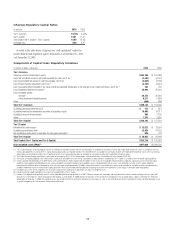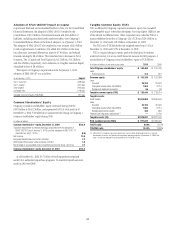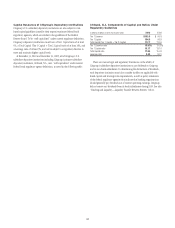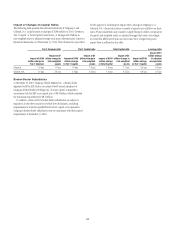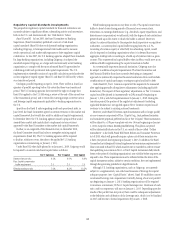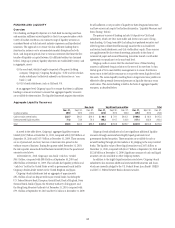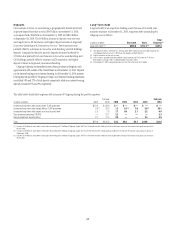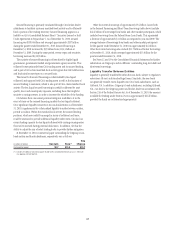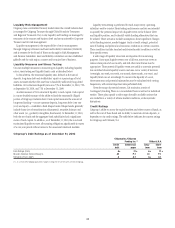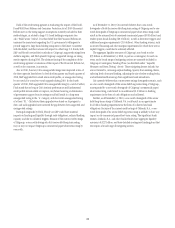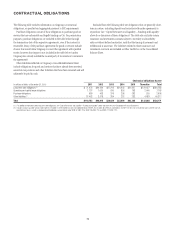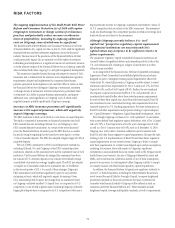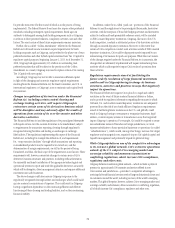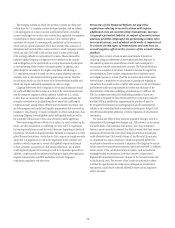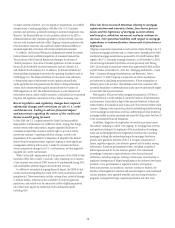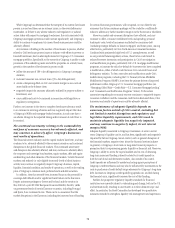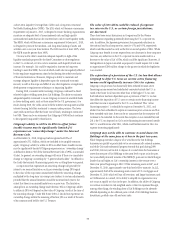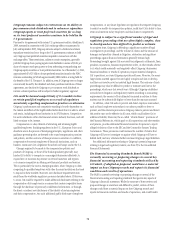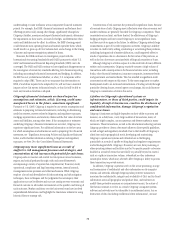Citibank 2010 Annual Report Download - page 71
Download and view the complete annual report
Please find page 71 of the 2010 Citibank annual report below. You can navigate through the pages in the report by either clicking on the pages listed below, or by using the keyword search tool below to find specific information within the annual report.69
Each of the credit rating agencies is evaluating the impact of the Dodd-
Frank Wall Street Reform and Consumer Protection Act of 2010 (Financial
Reform Act) on the rating support assumptions currently included in their
methodologies, as related to large U.S. bank holdings companies (see
also “Risk Factors” below). It is their belief that the Financial Reform Act
increases the uncertainty regarding the U.S. government’s willingness to
provide support to large bank holding companies in the future. Consistent
with this belief, and their actions with respect to other large U.S. banks, both
S&P and Moody’s revised their outlooks on Citigroup’s supported ratings from
stable to negative, and Fitch placed Citigroup’s supported ratings on rating
watch negative, during 2010. The ultimate timing of the completion of the
credit rating agencies’ evaluations of the impact of the Financial Reform Act,
as well as the outcomes, is uncertain.
Also in 2010, however, Citi’s unsupported ratings were improved at two of
the three agencies listed above. In both the first quarter and fourth quarter of
2010, S&P upgraded Citi’s stand alone credit profile, or unsupported rating,
by one notch, for a total two-notch upgrade during 2010. In the fourth
quarter of 2010, Fitch upgraded Citi’s unsupported rating by a notch. Further,
Fitch stated that as long as Citi’s intrinsic performance and fundamental
credit profile remain stable or improve, any future lowering or elimination
of government support from its ratings would still result in a long-term
unsupported rating in the “A” category, and short-term unsupported rating
of at least “F1.” Citi believes these upgrades were based on its progress to
date, and such upgrades have narrowed the gap between Citi’s supported and
unsupported ratings.
Ratings downgrades by Fitch, Moody’s or S&P could have material
impacts on funding and liquidity through cash obligations, reduced funding
capacity, and due to collateral triggers. Because of the current credit ratings
of Citigroup, a one-notch downgrade of its senior debt/long-term rating
may or may not impact Citigroup’s commercial paper/short-term rating by
one notch.
As of December 31, 2010, Citi currently believes that a one-notch
downgrade of both the senior debt/long-term rating of Citigroup and a one-
notch downgrade of Citigroup’s commercial paper/short-term rating could
result in the assumed loss of unsecured commercial paper ($8.9 billion) and
tender option bonds funding ($0.3 billion), as well as derivative triggers and
additional margin requirements ($1.0 billion). Other funding sources, such
as secured financing and other margin requirements for which there are no
explicit triggers, could also be adversely affected.
The aggregate liquidity resources of Citigroup’s non-bank stood at
$95 billion as of December 31, 2010, in part as a contingency for such an
event, and a broad range of mitigating actions are currently included in
Citigroup’s Contingency Funding Plans (as described under “Liquidity
Measures and Stress Testing” above). These mitigating factors include, but
are not limited to, accessing surplus funding capacity from existing clients,
tailoring levels of secured lending, adjusting the size of select trading books,
and collateralized borrowings from significant bank subsidiaries.
Citi currently believes that a more severe ratings downgrade scenario, such
as a two-notch downgrade of the senior debt/long-term rating of Citigroup,
accompanied by a one-notch downgrade of Citigroup’s commercial paper/
short-term rating, could result in an additional $1.2 billion in funding
requirement in the form of cash obligations and collateral.
Further, as of December 31, 2010, a one-notch downgrade of the senior
debt/long-term ratings of Citibank, N.A. could result in an approximate
$4.6 billion funding requirement in the form of collateral and cash
obligations. Because of the current credit ratings of Citibank, N.A., a one-
notch downgrade of its senior debt/long-term rating is unlikely to have any
impact on its commercial paper/short-term rating. The significant bank
entities, Citibank, N.A., and other bank vehicles have aggregate liquidity
resources of $227 billion, and have detailed contingency funding plans that
encompass a broad range of mitigating actions.


